Naturally, the use of fossil fuels has associated dangers. However, the safe use of any fuel type is a critical aspect of their use.

Image Credit: petrmalinak/Shutterstock.com
Safety focuses on preventing situations where the three combustion factors; oxidant (air), ignition source (heat or spark), and the fuel present. A thorough understanding of fuel properties allows for the design of fuel systems with appropriate engineering controls to ensure the safe use and handling of the fuel.
Hydrogen (H2) can be used to power domestic heating systems and powerful hydrogen engines like those in spacecraft or in cooling electric power turbines. Hydrogen is also used to make agricultural fertilizers and for renewable energy storage in tanks.
Some H2 properties make it more ideal when compared to other types of fuels. For example, it is a non-toxic gas that is lighter than air, so it easily dissipates when released. However, it is highly flammable and needs to be handled with care and the highest safety standards as it is virtually undetectable by human senses.
In many areas where hydrogen can be utilized, sparks from electrical components can cause catastrophic hazards, which can be fatal or cause devastating property damage. This calls for the need for new and improved detection systems to reduce the potential risks.
The Use Of Hydrogen As A Fuel And The Challenges Associated
There are some challenges in using hydrogen as a fuel that have to be addressed or considered to improve detection methods of hydrogen. These challenges include the cost to ensure the safe distribution system of the gas from the manufacturer to the consumers.
If hydrogen leak is not detected quickly during its transportation or distribution, huge gas volumes can be lost to the air, especially if the gas is highly pressurized. Such losses cannot be economical for the manufacturer hence the need for a modern or new way of detecting the gas leak as quickly and efficiently as possible.
Hydrogen quickly catches fire, especially in the presence of oxygen which can lead to catastrophic explosions if the leak is not detected quickly. The ignition energy of hydrogen is ten times higher than that of gasoline, which means that hydrogen will ignite easily and faster than common fuel sources.
Another challenge associated with hydrogen is that hydrogen flames are very dim and difficult to encounter.
A New Way To Detect Hydrogen
The current methods of leak detection are highly inefficient in sourcing the exact origin of the leaks; they frequently appear to be more successful in locating a general region where the gas is prevalent.
A new detection method includes an optical gas imaging camera to improve the efficiency of gas detection. This detection system can be coupled with a thermal imaging camera for carbon dioxide leak detection and can efficiently find hydrogen while using carbon dioxide as a tracer gas.
A single detector that can do this simultaneously would be of great relevance to help improve the safety standards of hydrogen detection. Traditional detection methods can take up to two weeks to detect in a power plant, stopping production and decreasing productivity.
Existing companies that are already manufacturing sensors can have their detectors enhanced with this new technology to improve their detection efficiency.
These new types of cameras have been well researched and established. The biggest problem this new detector faces is integrating these cameras to work with the already existing types of sensors.
Challenges And The Future Of Sensors
The right technology and skill set will be required to incorporate these cameras into already existing detection systems. More funding will be necessary to research and provide material to develop a prototype of these new-age hydrogen detectors.
There is still a lot of work that can be done to improve the current way in which hydrogen can be detected. The high potential risk of using hydrogen will require highly specialized detection systems to make it even safer to use.
Continue reading: Electric Vehicle Sensors for Leak Detection
References and Further Reading
Harrison, S., (2021) Rapid response, robust, low concentration hydrogen sensor sets new safety benchmark. [online] H2 View. Available at: https://www.h2-view.com/story/rapid-response-robust-low-concentration-hydrogen-sensor-sets-new-safety-benchmark/
Flir.eu. (2021) Avoid an outage with new hydrogen leak detection technology. [online] Available at: https://www.flir.eu/discover/instruments/gas-detection/avoid-an-outage-with-new-hydrogen-leak-detection-technology/
Nrel.gov. (2021) Safety, Codes, and Standards. [online] Available at: https://www.nrel.gov/hydrogen/safety-codes-standards.html
Office of Energy Efficiency and Renewable Energy (2021) Safe Use of Hydrogen. [online] Available at: https://www.energy.gov/eere/fuelcells/safe-use-hydrogen
Disclaimer: The views expressed here are those of the author expressed in their private capacity and do not necessarily represent the views of AZoM.com Limited T/A AZoNetwork the owner and operator of this website. This disclaimer forms part of the Terms and conditions of use of this website.